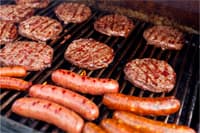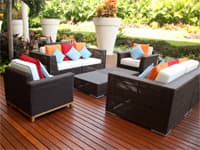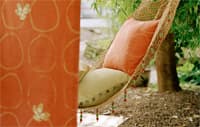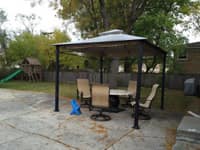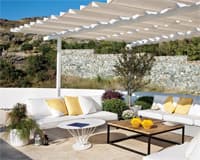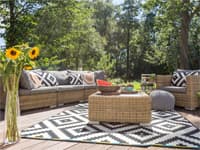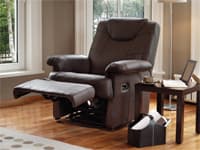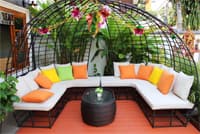
Casual Furniture Posts
With over 30 years experience factoring for the casual furniture industry, no one knows casual furniture like DSA Factors. Stay on top of industry news right here on the Factoring 101 Blog.
Jump to a Post
Another Successful Casual Market Chicago
Last week's Casual Market at the Merchandise Mart in Chicago was a successful one. While many of the exhibitors noted that there was lighter foot traffic than there had been in previous years, they mentioned that more of the attendees to the Casual Market knew what they were looking for going into the show and were placing orders. Here at DSA Factors we can already confirm this as several of our clients have already submitted numerous orders for approval this week, most of which are coming from brand new accounts. In fact one of our clients has already received over $100,000 in orders from brand new accounts and it has only been a week since the market came to a close!
The show featured quite a few new exhibitors, many exhibitors who were new to the show last year and were returning for their second show, as well as all of the usual exhibitors who have been making the annual trip to the Mart for a long time now. Once again DSA Factors was present at the show and if you were exhibiting there is a very good chance that you would have spoken with Ben. However, if you somehow missed Ben at the show, or you didn't attend this year, don't worry, he is always available and can be reached by phone at 773-248-9000 or via e-mail at ben@dsafactors.com.
For those of you unfamiliar with the Casual Market Chicago, it is the premier trade show for the casual furniture industry and is put on each September at the Merchandise Mart by ICFA (International Casual Furnishings Association). It features a large number of temporary exhibitors on the very busy seventh floor, as well as several floors of permanent showrooms. Exhibitors at the show sell everything including outdoor dining sets, chat groups, fire tables and fire pits, outdoor fabrics, cushions, umbrellas, hammocks, bean bag chairs, grills, outdoor rugs, lighting, wall decor, and everything else you would need to complete an outdoor room.
DSA Factors has been involved in the furniture industry for over 60 years and has been providing accounts receivable factoring for furniture manufacturers and importers for the last 30 years. Our clients sell everything from indoor to outdoor furniture, cushions, rugs, umbrellas, lighting, decorative accessories, and much more. In addition to accounts receivable factoring, DSA Factors also offers our clients purchase order financing so that they have the funds necessary to fulfill large orders. If you are in need of improved cash flow, or just want someone to take care of and insure your accounts receivable, choose DSA Factors, we have the experience you need to grow your business.
Barbeque Season
The weather is starting to warm up, and with that more and more people are firing up their grills. The only question is which grill will people be using. Although two thirds of all grills are less than five years old, nearly half of all grillers, 45%, are planning on buying a new grill or smoker this year. The most important factors consumers look at when buying a new grill are taste, quality, safety, and price. And it isn't just grills that people are looking to buy, grilling accessories are also on many consumers' shopping list.
When it comes to type of grill owned, grills that run on a propane tank are by far the most popular with nearly two thirds of grillers owning one. After propane comes charcoal, with half of all grillers owning a charcoal grill. Electric grills, such as a George Forman Grill, are owned by 12% of grillers, while natural gas grills are owned by 11% of grillers. Less popular are pizza ovens, fire pits with cooking grates, and smokers. Approximately one in ten grillers own an entire outdoor kitchen, and a third of them are most likely going to update their outdoor kitchen within the next three years.
84% of all grillers say that they are satisfied with their grill. Owners of electric grills are most satisfied with their grill, with nine out of ten grillers saying that they are satisfied. Areas that they would look to see improvement in however are lighting, removable heating elements, and cooking ability. More than eight in ten grill owners are satisfied with their propane grills and charcoal grills, while just less than eight in ten are satisfied with their natural gas grills. With gas grills the most wanted improvement is with grease evacuation, while charcoal grill owners would like to have the ability to control the temperature. While overall grillers are very satisfied with their grills, only about one third are satisfied with their grilling accessories. The most commonly owned accessories are cleaning brushes, long-handled utensils, gloves, and cutting boards.
Of course summer is the most popular time for grilling with more than one in five grillers saying they grill almost every day and three quarters saying they grill every week. Spring and Fall sees a little drop off in grilling with not quite half of all grill owners using their grills each week. But winter doesn't necessarily mean its the end of the grilling season, over a three quarters of all grillers say they still grill a little over the winter, with almost half grilling several times each month. Of course, holidays are the most popular times for grilling. You will find three quarters of all grillers busy in their backyards over the Fourth of July. Nearly two thirds will be busy for both Memorial Day and Labor Day. Half of them will be grilling on Father's Day and a third on Mother's Day. The next busiest day comes in the middle of winter as a quarter of all grillers will brave the cold on Super Bowl Sunday. Less popular holidays are Easter, Thanksgiving, Cinco de Mayo, New Year's, Christmas or Chanukah, Columbus Day, and St. Patrick's Day. The least popular holiday is Valentine's Day where only one in twenty grillers will be cooking for their loved one.
The most popular reason for grilling is improved flavor, over seven in ten grillers state this as a reason for why they grill. A little over half of grillers say they do it for enjoyment. Four in ten grill when they entertain others. A third say that they grill out of convenience. Nearly six in ten gas grillers own a grill with a side burner, although most say that they never use it. Just over half of grillers who own a propane gas grill only own a single propane tank. And just over half of grillers with a charcoal grill will use standard charcoal briquettes which they light with lighter fluid.
As the weather and grill sales start heating up, its important if you are sell grills, grilling accessories, or casual furniture that you have the cash flow to keep up with demand. The fastest and easiest way to speed up your cash flow is with accounts receivable factoring. Call DSA Factors today at 773-248-9000 and let us use our 30 years of experience to help you meet your seasonal demands.
Chat Group Sales on the Rise
Chat group sales have been on the rise, and all signs show that they will continue to rise. According to Casual Living total sales for chat groups reached $1.09 billion in 2015, a 6.4% increase over 2014's $1.02 billion, and 37% of consumers that they surveyed plan to purchase chat group furniture to improve their outdoor spaces in 2016.
The most popular piece of furniture included in chat groups are chairs with 89% of chat groups including at least one chair. Chairs are closely followed by occasional tables which can be found in 73% of chat groups. After that the numbers drop down significantly. Only 36% of chat groups feature sofas, while 27% of chat groups contain a love seat. 24% of chat groups are centered around a fire pit, and 20% of them include an ottoman.
As for how many people chat groups can seat, 40% of chat groups in the US can seat 4 people comfortably, while 24% seat 6 comfortably. After that you will find the 18% of chat groups can only seat 2 people, while 13% of chat groups can seat 8 people. Only 5% of chat groups can seat 10 or more people comfortably. However, in the Northeast chat groups run a bit larger, approximately one third of chat groups in the Northeast are capable of seating 8 people comfortably.
When it comes to how long consumers expect their chat group to last, a little less than half of all consumers expect to only get as much as 5 years out of their chat group, while only one in ten consumers expects their chat groups to last more than 10 years. On average, consumers expect their chat group to last for about 6 years. These numbers do however vary my region and demographics. Those who live in colder climates tend to expect more life out of their chat groups. In the Northeast consumers expect their chat group to last for 10 years on average, while in the Midwest consumers expect to get 8 years out of their chat group. However, in the South consumers only expect to get 6 years out of their chat group on average, and in the West this number drops down to only 5 years. When it comes to income level, middle income consumers, those making between $50,000-$100,000 a year, expect to get 10 years of life out of their chat groups, while lower income and higher income consumers only expect to get 5 or 6 years out of their chat groups. Baby Boomers also expect a lot, they look to get 10 years out of their chat group, while Millennials and Generation Xers only expect to get 5 years.
The most popular months for buying furniture for a chat group, which should come as no surprise, are March thru June. May is by far the most popular month with nearly a quarter of all sales coming in that month. However, in the Midwest, consumers like to shop a bit early, making March the Midwest's most popular month for casual furniture sales. Sales are pretty flat in July, but pick up a little in August as retailers tend to put existing stock on sale before sales die down for the winter.
With the casual furniture industry headed into its busy season, its important that you are able to keep up with growing demand. As the orders are coming in, if you need help with your cash flow, give DSA Factors a call today at 773-248-9000. We have the experience and expertise you need to help grow your business and manage seasonal demands through our accounts receivable factoring.
Color is Most Important Factor in Choosing Outdoor Fabrics
When it comes to choosing an outdoor fabric, 98% of retailers and 100% of designers consider color to be very important to the customers according to a recent study by Casual Living. But what colors people choose depends on the type of chair and who you ask. According to retailers, just over three quarters of consumers like grays when it comes to cushions, while two thirds like blues, and slightly less than half like browns. When it comes to slings, just over seven in ten consumers like browns, and just less than seven in ten like grays, while not quite three in ten consumers like blues. When it comes to pillows things get a bit more colorful. A bit more than three quarters of consumers like blues, while slightly less than six in ten consumers like oranges, with reds trailing oranges by just a few percent.
However, if you ask designers, they feel fairly confident that blue is the most popular color for cushions, slings, and pillows, and expect blues to be the best selling color of 2016. Regardless of who you ask or what color you choose, customers are staying away from light fabrics that get dirty easily.
Given the fact that color is such an important factor in choosing a fabric, it should come as little surprise that consumers biggest concern with fabrics is fade resistance. 96% of retailers state that customers ask about fade resistance. The next biggest concern is how quickly the fabric dries, followed by stain resistance, mildew resistance, and then water resistance.
After color, the next most important factors in choosing a fabric according to retailers are durability, coordinating fabrics with a group, and design and pattern, all of which are important to 90% or more of consumers. Fabric softness and fell along with care and maintenance are both important to more than 80% of consumers. Surprisingly affordability is near the bottom of the list of important factors, with less than two thirds of consumer concerned about the price tag.
While only nine in ten retailers stated that design and pattern are important to consumers, all designers surveyed stated that design and pattern are very important to their customers. When it comes to cushions and slings, solid patterns are far and away the most popular. Stripes come next, for cushions they're popularity is about half that of solids, while for slings they're popularity is about a third that of solids. Abstract and geometric patterns are just about the only other design that get a modest amount of interest for cushions and slings. However, when it comes to pillows consumers are looking a lot of different patterns. Over three quarters of consumers consider abstract and geometric patterns for their pillows. Two thirds consider botanical, leaf, and flower patterns for their pillows. While just over half consider paisleys and scrolls, and just under half consider stripes. Animal prints, which receive interest from a little more than a third of consumers, also are more popular than solids which receive interest from one third of consumers who are buying pillows.
Off the floor fabrics and custom or special-order fabrics pretty much split the fabric market evenly. Retailers report that just over half of sales are for off the floor fabrics, while designers report that just over half of sales are for custom or special-order fabrics.
If you are in the casual furniture industry and are getting ready for a busy casual season ahead of you, now would be a great time to give DSA Factors a call at 773-248-9000. You will no longer need to worry about seasonal cash flow problems, and will have the confidence of working with a partner that has been factoring for the furniture industry for 30 years.
Outdoor Furniture Market Projected to Finish the Year Up 4.5%
In a study performed by Casual Living, the outdoor market will have total sales of nearly $6.9 billion for 2015, up 4.5% over 2014's $6.6 billion. This is good news for the furniture industry and economy as 2014 saw a 3.9% increase while 2013 only saw a 1.3% increase. Leading the way are grills which hold a 36% share of the market followed closely by dining sets at 30%. Other important categories include chat groups with a 16% market share, shading with a 9% market share, and other seating options with a 5% share of the outdoor furniture market.
Grill sales are projected to total $2.5 billion for 2015, up 4.6% from 2014's $2.39 billion. Dining sets will reach $2.1 billion, up 3.3% from last year's $2.03 billion. The largest jump came from chat groups whose sales are up 6.4% over last year, they are projected to reach $1.09 billion for 2015. Shading also experienced a big boost with projected sales to reach $592 million, a 5% jump from 2014's $564 million.
This year, 4% of all American households either have or plan to purchase an outdoor dining set, that translates to roughly 4.7 million households, with the median price point for a new set being $150. By region, dining sets are most popular in the Midwest where 4.4% of households purchased a new set this year, followed closely by the West where the number was 4.3%, in both these regions the median price point on a set was $100. The South was even with the national average with 4% of households buying a new dining set but ahead of the national average with a median price point of $200. While in the Northeast only 3.2% of households bought a new dining set, those that did spent more money with a median price tag of $300. When it comes to what people are looking for in a dining set, the most important feature is price, this is especially true in the Midwest where 78% of consumers mention price as an important feature. Price is also the most important feature in the West where 62% of consumers look at it, and in the South where 59% of consumers consider it. The other important features in these three regions are quality and durability as well as style and design. In the Northeast where 57% of consumers consider price an important feature, it falls behind quality and durability which is important to 71% of consumers and style and design which is important to 79% of consumers, perhaps explaining why fewer people in the Northeast are buying outdoor dining sets but are spending more money on them. The least important feature to consumers was brand, which less than 10% of consumer find important nationwide.
Chat groups were purchased by 1.5% of American households this year, which translates to 1.7 million households with a median price tag of $300. However, unlike dining sets, the richer you are, the more you spend on a chat group. For households making less than $100,000 a year, the median price for a chat group was $225. For households making between $100-150 thousand, the median price jumps up to $1500, and for those making over $150,000 the median price is $2325. While these affluent households might only account for 19% of the households that purchased a chat group, they account for 65% of dollars spent on them. For these affluent buyers, nearly all of them are consider the style and design to be the most important factor when purchasing a chat group. For middle and lower income households quality and durability along with price are the most important factors in choosing a chat group.
While these cold winter months may not be the best time for the casual furniture industry, they offer suppliers the time they need to prepare themselves for the busy season ahead of them. If you are have seasonal cash flow problems, or you are experiencing higher sales volumes and need help keeping up with higher demand, now would be a great time to give DSA Factors a call at 773-248-9000. We have been factoring for the furniture industry since 1986 and have the experience and know-how you need to take your business to the next level.
Patios: The Most Popular Outdoor Space
In a recent survey done by Casual Living, it was found that one third of all Americans use their patios. Six out of ten houses have a patio, and just over half of all houses have a porch, while slightly less than half of them have a deck. When it comes to condos, four out of ten have a patio, three out of ten have a balcony, while porches and decks each appear in two out of ten condos. For apartment dwellers, almost half of them have a balcony, while just less than a third of them have a patio, and two out of ten have a porch.
When it comes to how people use their patios, or other outdoor spaces, nine out of ten people use their outdoor spaces for relaxing, while nearly three quarters of Americans enjoy reading outside. Also popular are grilling, entertaining, and gardening with each activity being done by approximately seven out of ten Americans. About half of all Americans will have family meals, use a computer or tablet, and listen to music outside. Three in ten Americans enjoy sunbathing in their outdoor spaces, and nearly a quarter of all Americans use their outdoor spaces for playing with their children.
While just over four in ten Americans made upgrades to their outdoor spaces in the second half of 2014 and first half of 2015, six in ten Americans either have or are planning on making upgrades in the second half of 2015, with another two in ten planning on making upgrades in 2016. The most common upgrade by far is planting vegetation with over three quarters of all people who either made or plan to make upgrades planting new trees, flowers, or other vegetation. Next up is maintaining a deck or patio. Nearly half of all people who already made upgrades performed maintenance work on their deck or patio, with another third planning to do so. Other popular improvements include buying furniture and outdoor accessories, installing lighting, buying a grill, buying some sort of shade device, and performing other landscaping work. The least popular improvement is installing a new swimming pool.
When it comes to outdoor furniture, dining furniture is the most popular, closely followed by conversation groups, and then other seating options such as benches or hammocks, and finally fire pits. While alternative seating options and fire pits may be the least popular furniture choices, they are gaining in popularity as more people plan to purchase them than have already done so. Fewer people plan to buy outdoor dining furniture as have already done so, while conversation groups are remaining stable with just as many people planning on purchasing them as those who have recently done so.
With outdoor accessories it should come as no surprise that the most popular items are potted plants and flowers, with nearly nine in ten consumers who accessorize purchasing these. Just over half of people accessorizing will purchase decorative pillows, and a little less than half will purchase outdoor rugs. Tableware and wall decor are each purchased by about three in ten people accessorizing, while two in ten purchase statues.
For lighting, strands or strings of light bulbs are the most popular with just over half of all consumers using them. Only slightly less popular is hard-wired fixtures. After that about a third of people use lanterns and a quarter of people use landscape lighting. The less popular options include portable lamps, torches, candles, lighting under shading devices, and solar lights.
Finally with shading, a roof or umbrella is the most prevalent from of shade with a little less than half of all consumers using each. For umbrellas, table umbrellas are about twice as popular as free standing umbrellas. About one in ten Americans will use a tree for shade. The other less popular options include pergolas, awnings, gazebos, curtains, and screens.
With all these improvements being made in front and back yards across the country, if you manufacture products for the outdoors it is important that you have the ability to handle large orders if you want your merchandise to be stocked with major retailers. Let DSA Factors help you grow your business. With nearly 30 years of experience in the furniture and accessories industries, we have the ability to provide you with the cash flow you need while also managing and insuring all of your receivables. Give us a call today at 773-248-9000 and find out how we can help your business grow.
Designing Outdoor Spaces
In a recent survey conducted by Houzz in was found that 80% of homeowners hired professional help to renovate their house last year, with 60% of homeowners making upgrades to outdoor spaces. The most common upgrade was to patios, decks, and terraces. With over half of all outdoor spaces being designed for year-round use, it should come as no surprise that the most active regions for improvements to outdoor spaces were in the South and West.
Designers try to create outdoor spaces that will allow you to do everything that you normally do indoors, effectively expanding your home to the outdoor space. The majority of designers will even try to match the styles and colors you have inside your house to what they are designing for the outside. They primarily focus on three activities when designing an outdoor space, entertaining, relaxing, and cooking. For an outdoor space, designers on average spent $6500 on outdoor furniture this year, a 37% increase from last year when they spent only $4750. They also spent an average of $1500 on grills, up 25% from last year. But the biggest change is in outdoor accessories such as rugs and wall decor, designers spent $2000 on average for these items, an 82% increase from 2014's average of $1100. Perhaps the main reason for this tremendous increase in spending on accessories comes from the desire to make outdoor spaces feel more like indoor spaces.
The only items that designers are spending less on this year is outdoor lighting, which at $2000 on average is down 11% from last year. This is a bit surprising since the most common technology designers incorporate into outdoor spaces is LED lighting. But as improvements are being made in this new technology, prices for LED lighting have been dropping.
Designers are also focusing less on more traditional uses for outdoor spaces. Only 57% of designers include plans for gardening in their designs. 45% will include plans for playing with children. While only 43% will include plans for sunbathing and swimming. This further emphasizes the idea that the space outside of your home is just an extension of the space inside your home, instead of being a completely separate space devoted to only outdoor activities.
Designers most typically source products for outdoor spaces at trade shows and design centers, but many of them also go to casual furniture stores or look online. If you are a supplier of casual furniture or accessories it would be a good idea to make sure that you product can be found in these places. If you need help with cash flow so you can attend the markets, or need to start offering net 30 day terms on your invoices, give DSA Factors a call at 773-248-9000. We have been factoring for the furniture and accessories industry since 1987 and are very familiar with the seasonal nature of the casual furniture industry. Also, look out for us as we will be visiting the Casual Market Chicago from September 16-19.
Outdoor Rugs - The Newest Trend in the Furniture and Accessories Industry
One of the biggest trends in the last few years has been creating outdoor rooms. While this has been great for the outdoor furniture industry, it has also been great for the outdoor rug industry. And while the furniture companies are playing it safe with neutral colors, the rug companies are offering colors that hadn't been available in outdoor spaces in the past.
While people do like to have color in the outdoor rooms, its a lot safer to use a neutral colors for the expensive furniture rather than invest all of your money in a bright red couch. As a result the furniture manufacturers have been sticking to the browns and beiges that they know work. However, with rugs being much more affordable, only taking up about 10-15% of the price that consumers will pay for an outdoor space, consumers are willing to take more of a chance on introducing color to the space with a bright red rug.
Rug manufacturers have taken notice of this and as durable technologies are improving, they are offering more and more colorful designs in materials durable enough to stand up to the outdoors. In fact technology has improved so much in recent years that an outdoor rug can look just as nice as an indoor rug. And since outdoor rugs tend to be much cheaper than indoor rugs, some people are even purchasing outdoor rugs for inside their house.
Of course it isn't just consumers and manufacturers that are excited about outdoor rugs these days, but also outdoor furniture retailers. These outdoor furniture stores are starting to realize something that their traditional indoor counterparts have known for years. One of the best ways to increase sales figures by 15% is to sell accessories. It doesn't require attracting more customers to your store, all you have to do is sell more items to the customers who are already buying.
But just like in a traditional furniture store, outdoor furniture stores need to stage these rugs correctly. It is important to pair appropriate rugs with outdoor furniture sets so that the customer can get a feel for how their outdoor space will look. Simply throwing all the rugs into a corner of your store, or pairing a traditional rug with a modern furniture set is not going to help sell rugs to your customers. However, even if staged properly it might not be the style that your customer is looking for. It is important that in the same way you would display fabric samples for upholstered furniture, you also need to display different styles and textures for outdoor rugs.
If you are a rug manufacturer, now would be a great time to get into the outdoor rug market. Or if you already make outdoor rugs, this would be a great time to expand your product line. This is a fast growing sector of the rug industry, and it hasn't been over-saturated with competition yet. If you need money to expand your product line, or you can't handle the demand you are experiencing for your current product line, give DSA Factors a call today at 773-248-9000. We have been specializing in the furniture and accessories industry since 1987. With our accounts receivable factoring services you can speed up your cash flow and save you time on credit checks and collections so that you can focus on what really matters.
Baby Boomers Fueling Recliner Sales
In a recent report in Furniture Today it was found that Baby Boomers ages 51-69 account for 40% of all recliner sales and 49% of all money spent on recliners. The 72 million Baby Boomers account for 30% of America's adult population and spent roughly $35 billion on furniture in 2014.
The Boomers get divided into two groups, younger boomers age 51-59 and older boomers age 60-69. For younger boomers the top three items that they plan purchase this year are motion sofas, mattresses, and recliners, while for the older boomers they are recliners, stationary chairs, and outdoor conversation groups.
Overall, with the exception of recliners, baby boomers are buying less furniture than other generations. However, just like with recliners, Boomers tend to be spending more money on these items than other generations are. While Boomers only buy 27% of all lamps, they account for 41% of the money spent on lamps. The other big categories include occasional tables, framed wall decor, entertainment furniture, and master bedrooms. While boomers only have a 20% share of master bedroom sales, they account for 32% of all the money spent on master bedrooms.
When it comes to colors of the furniture, Boomers favorite neutral colors are grays, whites, and beiges. Their favorite vibrant colors are reds and blues, with a little less interest in oranges, greens, and yellows.
Most importantly three quarters of all Boomers prefer to do their furniture shopping in brick and mortar stores over online stores, and great customer service is something that they look for in a furniture store. However, this doesn't mean that they don't use the internet while shopping for furniture. Nearly half of all Boomers will research a product online before purchasing it in a store. The most popular form of research is Googling a particular item, something which 36% of Boomers do. 22% of Boomers will read product reviews. Another 17% will read up on the product on the manufacturer's web site, while only 10% rely on furniture ads they've seen online.
If your struggling to stay on top of developments in the furniture, accessories, or giftware industries why not give DSA Factors a call today at 773-248-9000. Let us factor your accounts receivable so that you have more time to do whats important to help your company grow.
Outdoor Furniture and Living Trends Among the Wealthy
It is no surprise that the wealthier you are, the more you will spend on furniture. But it may surprise you where that money is being spent, especially when it comes to outdoor furniture. A recent study by Furniture Today looked at outdoor furniture sales in relation to the buyers wealth. They paid special attention to the 22% of American households that make over $100,000 a year.
When it comes to outdoor dining sets, these affluent Americans made up 28% of the market share and accounted for 37% of the total dollars spent. On average the wealthy spent twice as much on outdoor dining sets than the less affluent.
While the numbers for outdoor dining sets may not come as a big surprise, the money spent on outdoor conversation groups will certainly surprise you. Wealthy Americans only accounted for 19% of the market share in this category, but accounted for 65% of total dollars spent! While families making less than $100,000 a year spent on average $225 on conversation groups, those making between $100,000 and $150,000 spent $1500 on average, while those making over $150,000 a year spent $2325 on average, over 10 times what less affluent Americans spend.
The reason for these numbers may have to do with outdoor living space. Nearly 75% of all families who make over $150,000 a year have an outdoor room in their house, with another 17% in the process of planning or constructing one. For the families making between $100,000 and $150,000, 63% of them have outdoor rooms, with another 22% in the process of planning or constructing one.
For manufacturers of outdoor furniture this could be some important information to keep in mind. While it would be wise to offer a range of price points for outdoor dining sets, you may want focus more on high end conversation groups.
As the summer heats up and sales start growing, make sure that you aren't left behind. Let DSA Factors handle your receivables so you can focus more on sales and production. Call Howard today at 773-248-9000 to find out how we can help you with our accounts receivable factoring.

